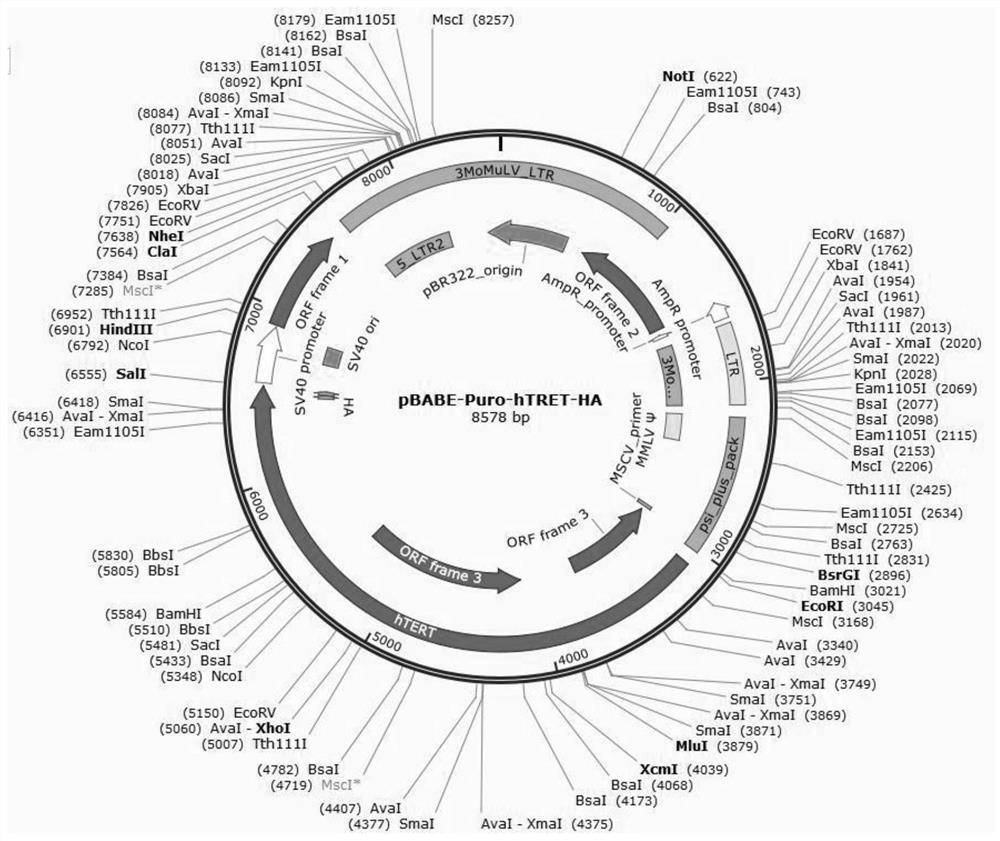Construction method of immortalized feeder layer cell strain, immortalized feeder layer cell strain and application
A feeder cell and construction method technology, applied in the field of immortalized feeder cell lines and its application, and construction of immortalized feeder cell lines, can solve the problems of low infection rate of primary cells and low success rate of feeder cell immortalization
- Summary
- Abstract
- Description
- Claims
- Application Information
AI Technical Summary
Problems solved by technology
Method used
Image
Examples
Embodiment 1
[0054] This embodiment provides a method for obtaining an immortalized feeder cell line by infecting BMI-1 gene and hTERT gene into feeder cells derived from fibroblasts, which specifically includes the following steps:
[0055] 1.1 Acquisition of recombinant plasmids
[0056] (1) Construction of PLV-EF1a-BMI-1-puro plasmid
[0057] Utilize PCR primers to clone BMI-1 gene from 293T cells, the resulting BMI-1 gene sequence is shown in SEQ ID No.1, and then the gained BMI-1 gene is connected to the PLV-EF1a-Puro lentiviral plasmid to construct PLV- EF1a-BMI-1-puro recombinant plasmid, PLV-EF1a-BMI-1-puro recombinant plasmid map as figure 1 As shown, the specific steps are as follows:
[0058] ①PCR reaction to amplify the target gene
[0059] The above PCR primer sequences are:
[0060] Forward primer sequence: CGGGATCCATGCATCGAACAACGAGAATCAAGA (SEQ ID No.2)
[0061] Reverse primer sequence: TGCTCTAGATCAACCAGAAGAAGTTGCTGATGAC (SEQ ID No.3)
[0062] The PCR reaction system i...
Embodiment 2
[0088] This example provides the application of the immortalized feeder cell line obtained in Example 1 in the functional identification of human primary tissue cells, which specifically includes the following steps:
[0089] The immortalized feeder cell line obtained in Example 1 was treated with 4ug / mL mitomycin and mixed with human primary tissue cells. After the mixed culture, it can successfully provide nutrition for human primary cells and support primary cell growth.
experiment example 1
[0091] The immortalized feeder cell line obtained in Example 1 and the non-immortalized feeder cell line were passaged at the same time, and the maximum number of passages was counted. The results showed that the maximum number of passages of the immortalized cell line obtained in Example 1 could reach more than 25 generations. After 5 generations of non-immortalized feeder cell lines (such as image 3 shown in a), and passed down to the immortalized feeder cell line for 3 generations (such as image 3 shown in b) and 20 generations (such as image 3 Shown in c) the obtained cell line is observed under a microscope, and the results are as follows image 3 As shown in the figure, it can be seen from the figure that the immortalized cells have no difference in cell shape compared with the non-immortalized cells, and the cells are in good condition, and there is no difference between the cell state at the 20th passage and the cell state at the 3rd passage.
PUM
 Login to View More
Login to View More Abstract
Description
Claims
Application Information
 Login to View More
Login to View More - R&D
- Intellectual Property
- Life Sciences
- Materials
- Tech Scout
- Unparalleled Data Quality
- Higher Quality Content
- 60% Fewer Hallucinations
Browse by: Latest US Patents, China's latest patents, Technical Efficacy Thesaurus, Application Domain, Technology Topic, Popular Technical Reports.
© 2025 PatSnap. All rights reserved.Legal|Privacy policy|Modern Slavery Act Transparency Statement|Sitemap|About US| Contact US: help@patsnap.com



